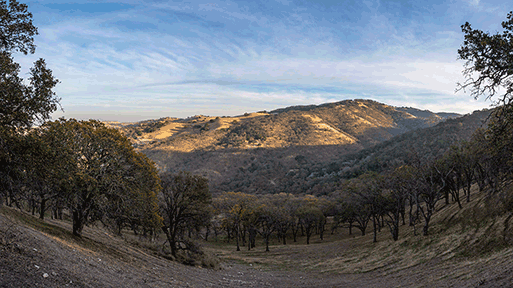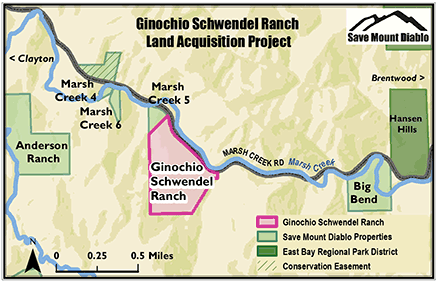CONTRA COSTA COUNTY, CA—Just in time for the holidays, Save Mount Diablo (SMD) has optioned the 98-acre Ginochio Schwendel Ranch on Marsh Creek Road between Clayton and Brentwood. The $30,000 option payment holds the property for 12 months while Save Mount Diablo raises almost $1.5 million for acquisition and other project expenses.
It’s the first property Save Mount Diablo is purchasing directly from Contra Costa County’s Ginochio cattle ranching family, which owns nearly 7,000 acres on and around Mount Diablo. The property includes extremely rare dacite volcanic habitat along Marsh Creek’s Dark Canyon section. The Ginochio Schwendel Ranch is the fifth acquisition project Save Mount Diablo has participated in this year. Save Mount Diablo expects to close escrow on its Krane Pond property next week on December 20th.
Save Mount Diablo’s Executive Director, Ted Clement, stated, “We are so thankful for our Save Mount Diablo team, including our amazing supporters, and the Ginochio family who together have enabled us to enjoy so much success this year in advancing our time-sensitive land conservation mission, even in the waning days of 2023. This is the first time Save Mount Diablo has bought a property directly from the Ginochio family, the most important landowning family in Contra Costa County. The Ginochios own several high priority properties on the slopes of the mountain. They’ve been amazing stewards of their land for generations. The Ginochio Schwendel Ranch will expand our abutting Marsh Creek 5 preserve. They both share very unusual volcanic geology and are in the high priority Marsh Creek wildlife corridor. If we don’t protect the Ginochio Schwendel Ranch, the property will eventually be divided up and developed, causing its special conservation values to be lost. We’re going to need help from our generous donors and agency partners to fund this project in the next 12 months.”

View from the Ginochio Schwendel Ranch. Photo by Scott Hein.
The Ginochio Family
The Ginochio family arrived in Contra Costa in 1867 and settled in Concord and the coal mining town of Nortonville, and then diversified into ranching. Over 156 years, they created and have stewarded the biggest cattle ranching operation in the county.
The Ginochios own nearly 7,000 acres, including the most important ranches remaining west, north, and east of Mount Diablo. Much of the land is in the Marsh Creek watershed, like the Ginochio Schwendel Ranch. But each generation has more family members, and over time, ranching has become more difficult.
Historically when the family has sold property, they’ve used the funds to buy more agricultural land. When another of their properties was condemned after World War II, the Ginochios bought the Schwendel Ranch. They will continue to own 665 acres north of Marsh Creek Road.
According to John Ginochio, a member of the ranching family, “I’m pleased to make this deal with Save Mount Diablo. When you think of influence, people often think about big environmental groups. Personally, I think Save Mount Diablo is the most influential environmental organization in our area. I’ve worked cooperatively with them for over 50 years. They’re financially sound and have the funds to make solid deals and the integrity to go with it. We graze cattle on a number of SMD properties. I’m happy to see this part of the Ginochio Schwendel Ranch go to Save Mount Diablo because they have always been a good neighbor.”
Added Ginochio, “This parcel south of Marsh Creek Road hasn’t been especially useful for cattle grazing but it’s always been interesting because of its unusual pink soil. I learned more about its volcanic character from Save Mount Diablo as they sponsored research on their neighboring property. I’m really happy we can help expand the protected volcanic habitat instead of more houses.”
The 98-acre Ginochio Schwendel Ranch would expand on Save Mount Diablo’s adjacent 7.4-acre Marsh Creek 5 preserve, an unusual volcanic dome. Marsh Creek 5 was protected in 2011. That same year and one parcel away, Save Mount Diablo also protected a similar volcanic dome, its 5.7-acre Marsh Creek 6 preserve, where the organization demolished a house overlooking the canyon and restored habitat.
According to Seth Adams, Save Mount Diablo’s Land Conservation Director, “The Ginochio Schwendel Ranch is part of the east-west Marsh Creek riparian, road, and trail corridor, and near the western end of the Dark Canyon section of the riparian corridor. Solid blue oak and live oak woodland, it is part of the wooded habitat corridor from Black Diamond Mines through Clayton Ranch south to Morgan Territory Regional Preserve and Mount Diablo State Park. Steep wooded slopes rise from Marsh Creek Road to flatter meadows, then climb higher in one direction, while dropping into a canyon in another. I consider John Ginochio a good friend and I hope this is just the first conservation project with the family.”
Ginochio Schwendel Ranch is a beautiful wooded 98-acre property, most of a steep volcanic knoll rising from 530 feet to 1,140 feet—with dramatic views. The property is quite visible from a variety of protected lands and from both directions of Marsh Creek Road. Development of the property would degrade the visual value of the road corridor, a Contra Costa County General Plan–designated “Scenic Route.” The most likely development threat is minor subdivision and ongoing fragmentation to more houses over time. Development would destroy the habitat, wells would damage the unusual hydrology, and roads and pads would require removal of many trees. Dark Canyon is a critical fire danger area, and part of the property burned several years ago.
Save Mount Diablo and our partners have protected more than 15 miles of the 33-mile Marsh Creek riparian corridor. Marsh Creek is the second longest, least-disturbed creek in Contra Costa County. The creek is across the road in this case, but the overall corridor and this upland habitat are very rich.
As with our neighboring Marsh Creek 5 preserve, we know the property supports listed species such as Alameda whipsnake and California red-legged frog, along with a whole suite of rare or unusual plants such as endemic Contra Costa manzanita and Mount Diablo fairy lantern, western hop tree, and Hartweg’s umbrellawort. An on-site fire road accesses the property and will allow much better access to our neighboring Marsh Creek 5 preserve. In the future, we hope the property will help with the creation of a section of the Clayton to Round Valley Marsh Creek Trail.
The Ginochio Schwendel Ranch is the fifth acquisition project Save Mount Diablo has participated in this year. After a successful community-based public fundraising campaign this fall, Save Mount Diablo expects to close escrow on its 6.69-acre Krane Pond property next week. Save Mount Diablo recently made its eighth installment payment on the 87-acre North Peak Ranch. In August, Save Mount Diablo purchased the critical 10-acre Balcerzak inholding within Mount Diablo State Park, situated in Curry Canyon, including the most remote house on Mount Diablo, in just a few weeks. And in April, the East Bay Regional Park District closed escrow on the $11.2 million 768-acre Finley Road Ranch property with Save Mount Diablo’s assistance, providing a location for a new regional staging area for Riggs Canyon and Morgan Territory Regional Preserve.
The Schwendels
We’re just getting to know the history of the property. The Schwendel Ranch was originally pieced together from homesteads and holdings by the heirs of railroad interests. One owner was Joseph or “Josef” Schwendel, a well-known Austrian musician who played the violin or cornet until his death in 1930. He was the organizer of the Clayton Silver Cornet Band in the 1870s. Frank Schwendel was born about 1883. Sometime during that period, Frank Schwendel took ownership of part of the land. Apparently, Mary Berendsen owned another part in 1927. When her husband died, she married Frank. They were still living in the area in 1940 when he was 57 and she was 63, and he still owned the land in 1946 when he granted an easement to PG&E. Schwendel children married members of the Frank family, who arrived in Clayton in the 1870s, and the Cakebread family. The Ginochio family bought their part of the Schwendel Ranch after World War II.
“Anna (Berendsen) Berkheimer has lived in Brentwood since 1981, but Clayton will always be her home. Berkheimer was born in Clayton . . . in a building that is known as the Clayton Club, a country and western bar,” according to the Clayton Historical Society and reprinted from an article that ran in the Brentwood News on August 13, 1987. “’Before Prohibition my father ran the saloon and mother took care of the dining room.’. . . ”Berkheimer was the daughter of Carl Berendsen, who emigrated to the United States from Denmark at the age of 17. Her mother’s parents were also from Denmark. . . . In 1926 her father drowned in Marsh Creek after driving his vehicle off the bridge and her mother subsequently married Frank Schwendel, who was born and raised in the Marsh Creek area. Schwendel owned 1,200 acres between Brentwood and Clayton and Berkheimer assisted with many of the chores on the ranch. ‘I learned how to milk cows, drive a tractor, and quite a few other things, but I really enjoyed it even though it was hard work,’ she said.”
Why Does the Ginochio Schwendel Ranch’s Geology Matter?
Complex geology = complex soils = rich botany. As rocks break down, soils are formed, and when the geology is complex, so are the soils. Because they’re high in some minerals, chemicals, and trace elements, and deficient in others, rocky soils often exclude some plants and are speciation sites where others evolve into new forms. These volcanic dacite intrusions are high silica and break down into sands that hold water and support a different plant community and rare plant species, often with springs on their slopes or base. Their vegetation is brighter green and lusher than surrounding areas, often dense with trees or poison oak.
A dozen volcanic, mostly dacitic intrusions have been mapped along Marsh Creek at the northeast corner of Mount Diablo State Park. In 2011, Save Mount Diablo protected 7.4-acre Marsh Creek 5, including one volcanic dome and then later that year a similar dome, 5.7-acre Marsh Creek 6. Another volcanic dome is found in Mount Diablo State Park at Perkins Canyon, which is easily accessible. Marsh Creek 5 and Marsh Creek 6 are two volcanic exposures on either side of the Marsh Creek Springs resort. These properties form a volcanic habitat found nowhere else in central or eastern Contra Costa County. The 98-acre Ginochio Schwendel Ranch is part of this same volcanic area.
There’s not as much igneous rock in Contra Costa County as in the North Bay, but it’s not all that unusual, especially on Mount Diablo. The most common igneous rocks on Mount Diablo are old ocean crust formed as much as 165 million years ago deep out at sea. These rocks included parts of Diablo’s main peaks. Also present are pillow basalts formed at underwater eruptions along a mid-ocean ridge. These pieces of igneous rock were carried to North America and added to the continent by the movement of tectonic plates.
In the Oakland hills, more recent volcanoes erupted and spread lava and ash locally around 10 million years ago. And in various places around Contra Costa County, ash from eruptions farther away are consolidated as “tuff” beds. The 4.83 million-year-old pink Lawlor Tuff is an age marker around Diablo, laid down on a flat to rolling landscape before the peaks were exposed, and steeply folded as Mount Diablo emerged.
Save Mount Diablo’s Marsh Creek 5 and Marsh Creek 6 properties are different. So is the Ginochio Schwendel Ranch.
We began studying the geology of the volcanic deposits after we acquired these Marsh Creek properties and sponsoring research into their origin in grants in 2018 and 2019 from our Mary Bowerman Science and Research program. Ultimately a chapter was included, “Neogene volcanism on the eastside of Mount Diablo, Contra Costa County, California” with findings in a new geology book, Regional Geology of Mount Diablo, California in 2021.
“Neogene volcanic rocks are located to the east and north of Mount Diablo, near the eastern boundary of the San Andreas fault system . . . probably associated with the northward migration of the Mendocino Triple Junction along the western plate boundary in California . . . This event produced a series of volcanic centers along the plate boundary . . . referred to as the Coast Range Volcanic Suite.” These dacite intrusions had not been previously radiometrically dated. The research Save Mount Diablo sponsored investigated their age, chemistry, and field relations and established their age as 7.5 to 7.8 Ma (“mega annum,” or “million years ago”).
These spots are of high silica, much younger igneous rock visible in mound- or dome-like surface exposures, within a four-mile northwest-southeast band, a mile and a half wide. They’re strangely steep because they resist erosion and look like mushroom caps, compared to more erosive sedimentary Great Valley Group geology nearby. Marsh Creek threads through them near the intersection of Morgan Territory and Marsh Creek roads. The volcanic intrusions are also one of the most limited habitats in the East Bay, retain water more than surrounding areas, and are often associated with springs and rare plants. The Ginochio Schwendel Ranch includes part of the biggest mapped exposure of these dacite intrusions.
The rare geology and plant habitat on the Ginochio Schwendel Ranch is just one more thing that makes Mount Diablo special.
About Save Mount Diablo
Save Mount Diablo is a nationally accredited, nonprofit land trust founded in 1971 with a mission to preserve Mount Diablo’s peaks, surrounding foothills, watersheds, and connection to the Diablo Range through land acquisition and preservation strategies designed to protect the mountain’s natural beauty, biological diversity, and historic and agricultural heritage; enhance our area’s quality of life; and provide educational and recreational opportunities consistent with protection of natural resources. To learn more, please visit www.savemountdiablo.org.
Previous Stories
- Aug 11 – Save Mount Diablo Protects Critical Balcerzak Inholding Property within Mount Diablo State Park
- Aug 4 – Couple Provides $100,000 Matching Challenge to Help Save Mount Diablo Protect the Krane Pond Property
- March 9 – Save Mount Diablo Unveils Long-Desired Knobcone Point Trail Connection
- Jan 5 – Save Mount Diablo Expands Its Free Discover Diablo Hikes and Outings Program for 2023

